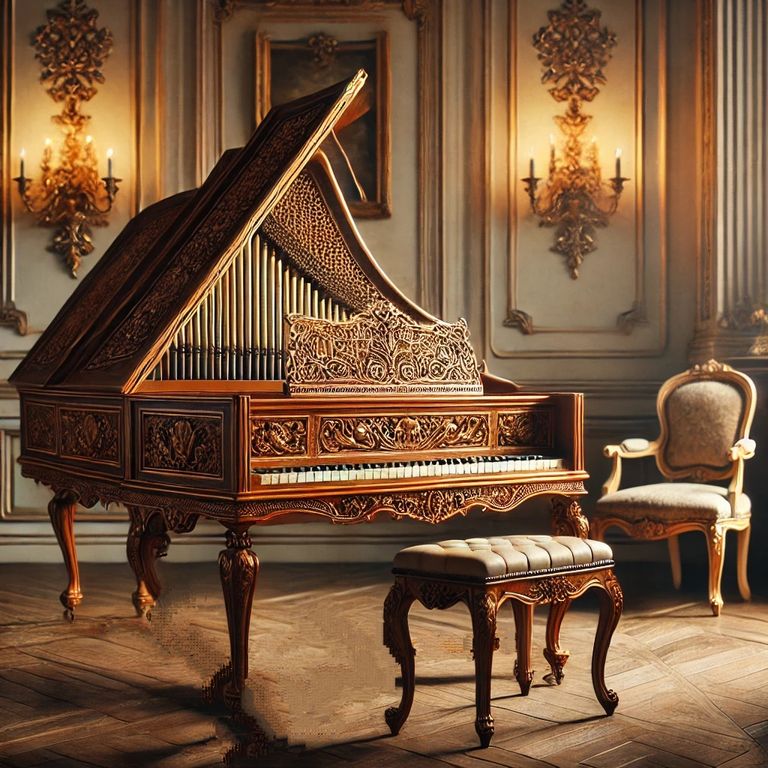
Hace poco volví a escuchar una de mis piezas favoritas de Johann Sebastian Bach: Air on the G String. Siempre me ha encantado disfrutarla en violín o piano, especialmente por su delicadeza y elegancia. Es una de esas melodías que parecen acariciar el alma. Sin embargo, esta vez me encontré con una interpretación que cambió mi perspectiva por completo: la versión en clavecín.
El clavecín era un instrumento desconocido para mí. Al principio, pensé que era un tipo de piano antiguo, pero al investigar un poco más, descubrí que su sonido es completamente diferente. Aunque por fuera puede parecerse al piano, el clavecín produce un timbre más ligero y cristalino, casi etéreo. No es de extrañar que este instrumento fuera uno de los favoritos de Bach. Sin embargo, es importante mencionar que Air on the G String no fue compuesta por Bach para clavecín, sino para una orquesta, pensada para instrumentos de cuerda como el violín.
Por curiosidad, busqué la pieza Air on the G String interpretada en clavecín y me sorprendió lo hermosa que suena. Aunque el piano y el violín siguen siendo mis instrumentos favoritos, el clavecín tiene un encanto especial. Escuchar este movimiento en este instrumento me permitió redescubrir la obra de una manera nueva.
Aquí es donde viene un dato interesante que aprendí: Air on the G String no es realmente el nombre original de la pieza. Se trata, de hecho, del segundo movimiento de la Suite orquestal No. 3 en re mayor, BWV 1068, una obra más extensa compuesta por Bach. El nombre Air on the G String surgió más tarde, cuando el violinista August Wilhelmj la adaptó para violín y piano, tocándola exclusivamente en la cuerda de sol (G string), lo que le dio ese nombre tan característico.
Lo curioso es cómo un movimiento de una obra completa puede cobrar vida propia y ser reconocido de forma independiente. El Air es uno de los movimientos más bellos y populares de esta suite, y su sencillez lo hace todavía más cautivador.
Desde entonces, he estado escuchando diferentes interpretaciones de esta pieza, cada una con su propio carácter. La versión en violín me sigue emocionando, el piano siempre será mi favorito, pero el clavecín ha ganado un lugar especial en mi corazón. Hay algo mágico en su sonido que me transporta a otra época.
La música clásica tiene ese poder de llevarnos en un viaje, de sorprendernos con nuevas versiones de algo que creíamos conocer. Y lo mejor de todo es que siempre hay algo nuevo por descubrir.
Recently, I revisited one of my favorite pieces by Johann Sebastian Bach: Air on the G String. I’ve always loved listening to it on violin or piano, especially because of its delicacy and elegance. It’s one of those melodies that seems to caress the soul. However, this time I came across a performance that completely changed my perspective: the harpsichord version.
The harpsichord was an unfamiliar instrument to me. At first, I thought it was just an old type of piano, but after doing some research, I discovered that its sound is completely different. While it may look like a piano, the harpsichord produces a lighter, more crystalline tone, almost ethereal. It’s no wonder this instrument was one of Bach’s favorites. However, it’s important to note that Air on the G String was not composed by Bach for the harpsichord, but rather for an orchestra, intended for string instruments like the violin.
Out of curiosity, I searched for the piece Air on the G String performed on the harpsichord, and I was amazed by how beautiful it sounded. Although piano and violin remain my favorite instruments, the harpsichord has a special charm. Listening to this movement on this instrument allowed me to rediscover the piece in a new way.
Here’s an interesting fact I learned: Air on the G String is not actually the original name of the piece. It is, in fact, the second movement of the Orchestral Suite No. 3 in D Major, BWV 1068, a more extensive work composed by Bach. The name Air on the G String came later, when violinist August Wilhelmj adapted it for violin and piano, playing it exclusively on the G string (G string), which gave it that distinctive name.
What’s fascinating is how a movement from an entire work can take on a life of its own and be recognized independently. The Air is one of the most beautiful and popular movements in this suite, and its simplicity makes it even more captivating.
Since then, I’ve been listening to different interpretations of this piece, each with its own character. The violin version still moves me, the piano will always be my favorite, but the harpsichord has earned a special place in my heart. There’s something magical about its sound that transports me to another era.
Classical music has that power to take us on a journey, to surprise us with new versions of something we thought we knew. And the best part is that there’s always something new to discover.
